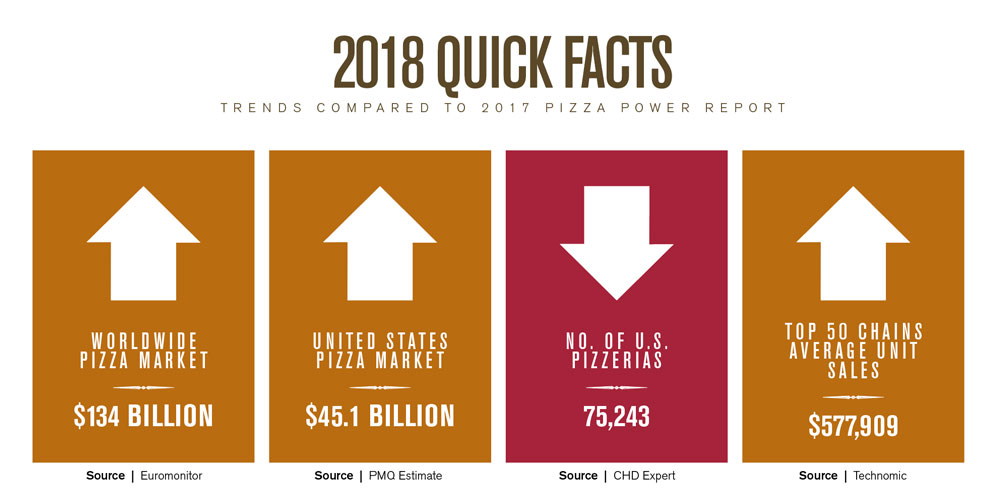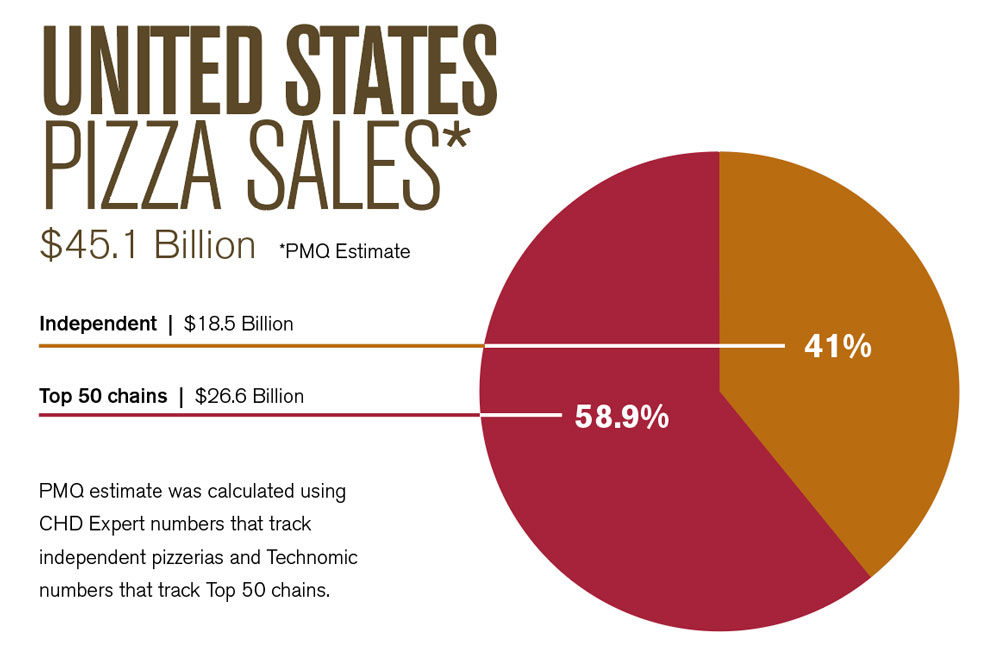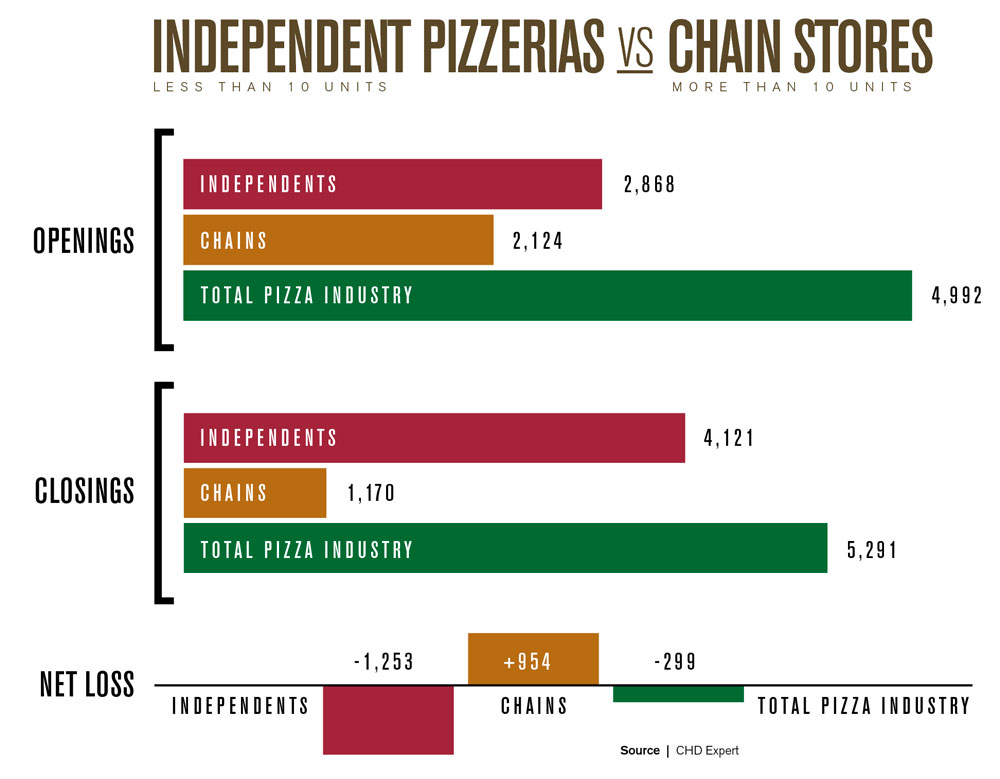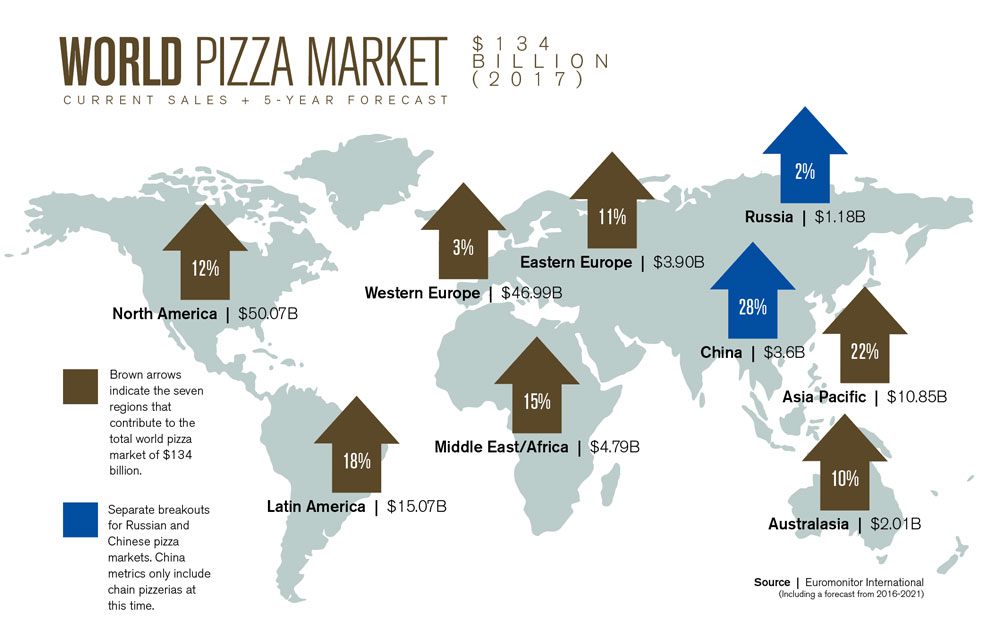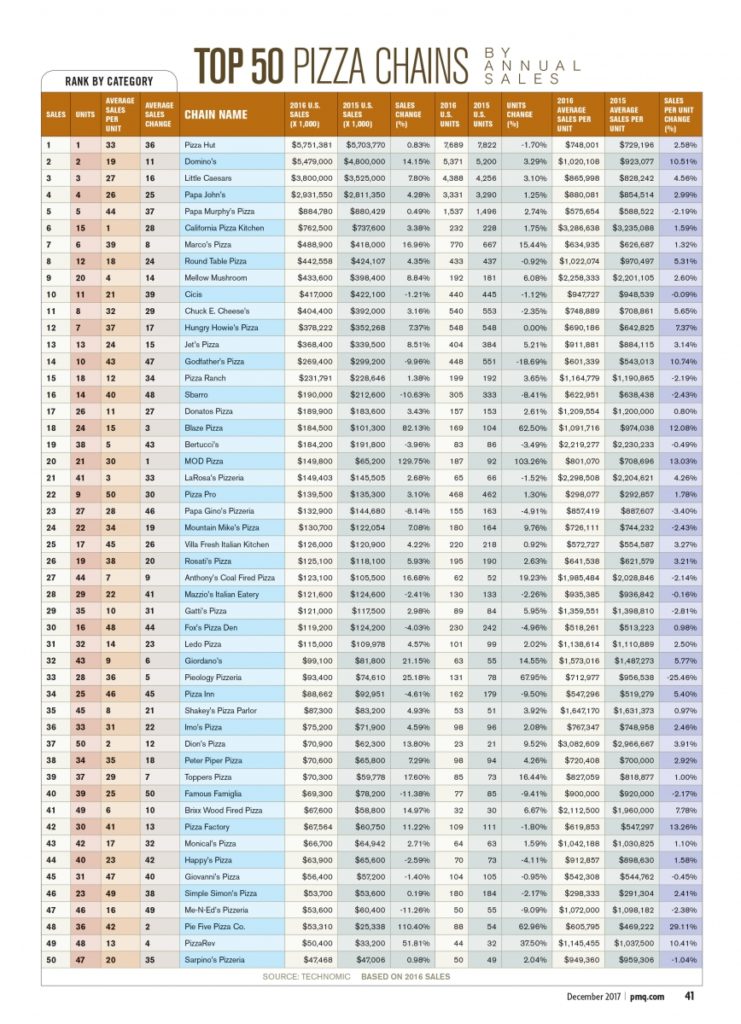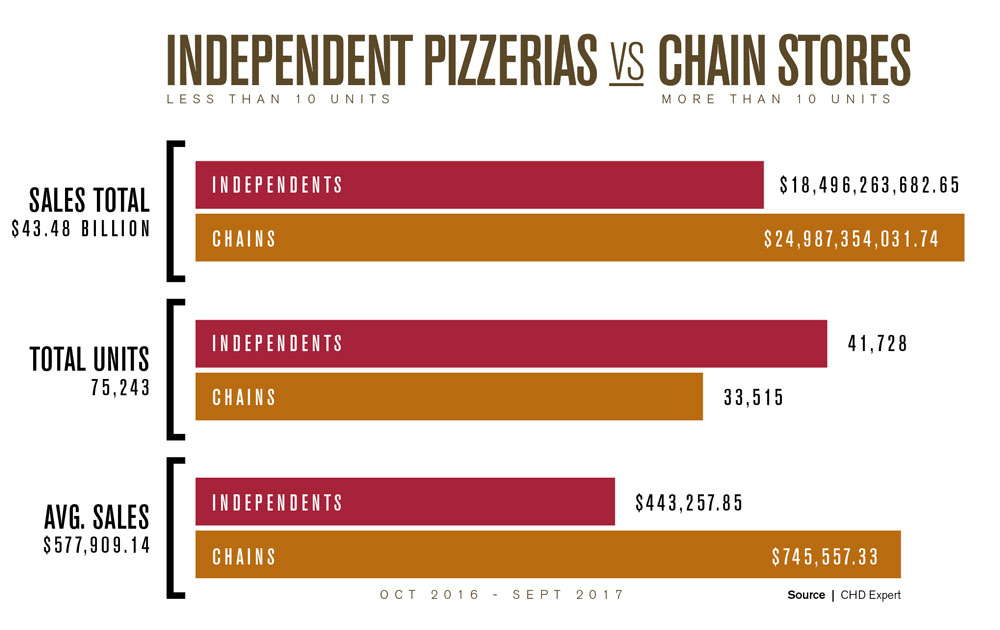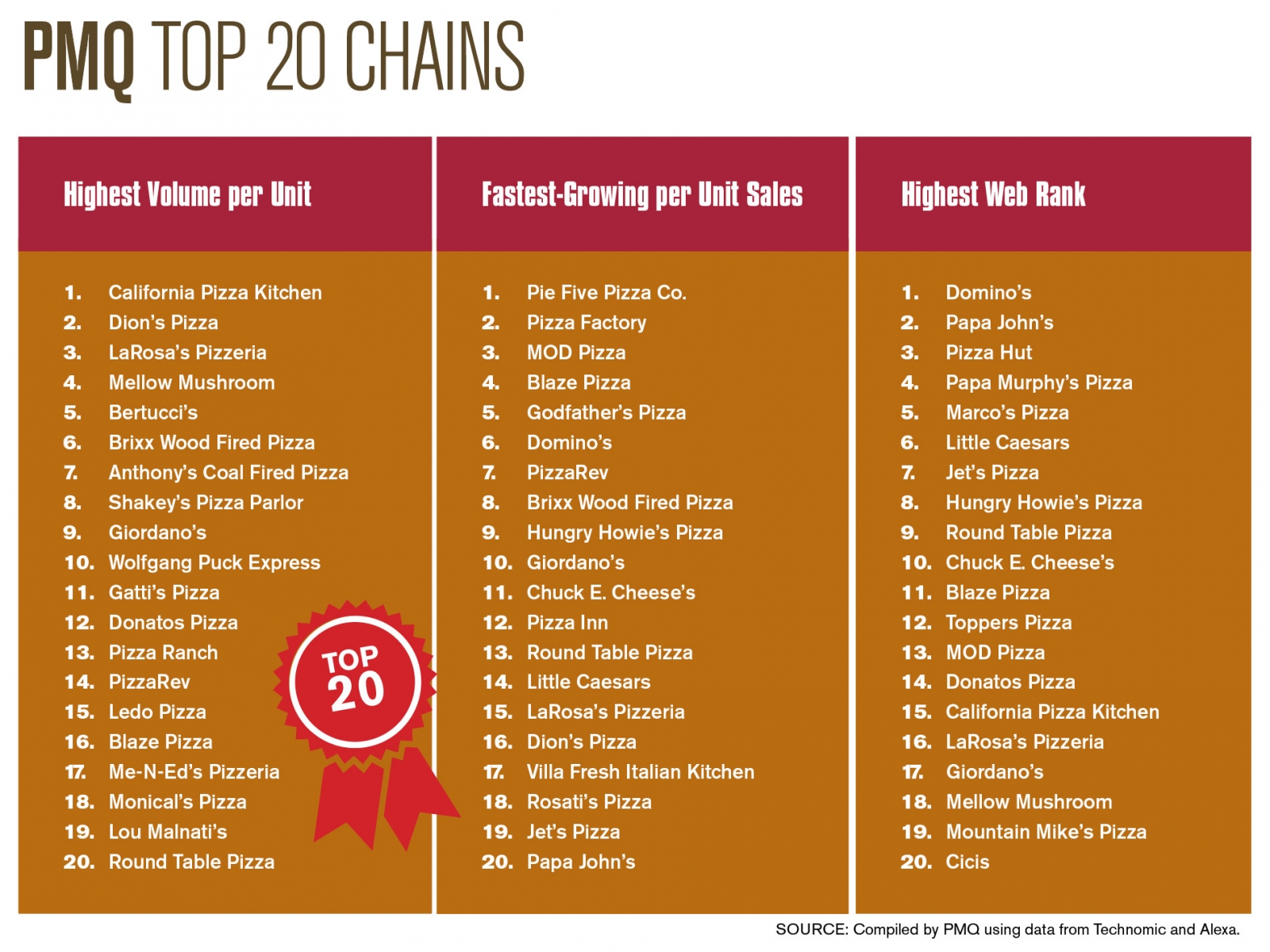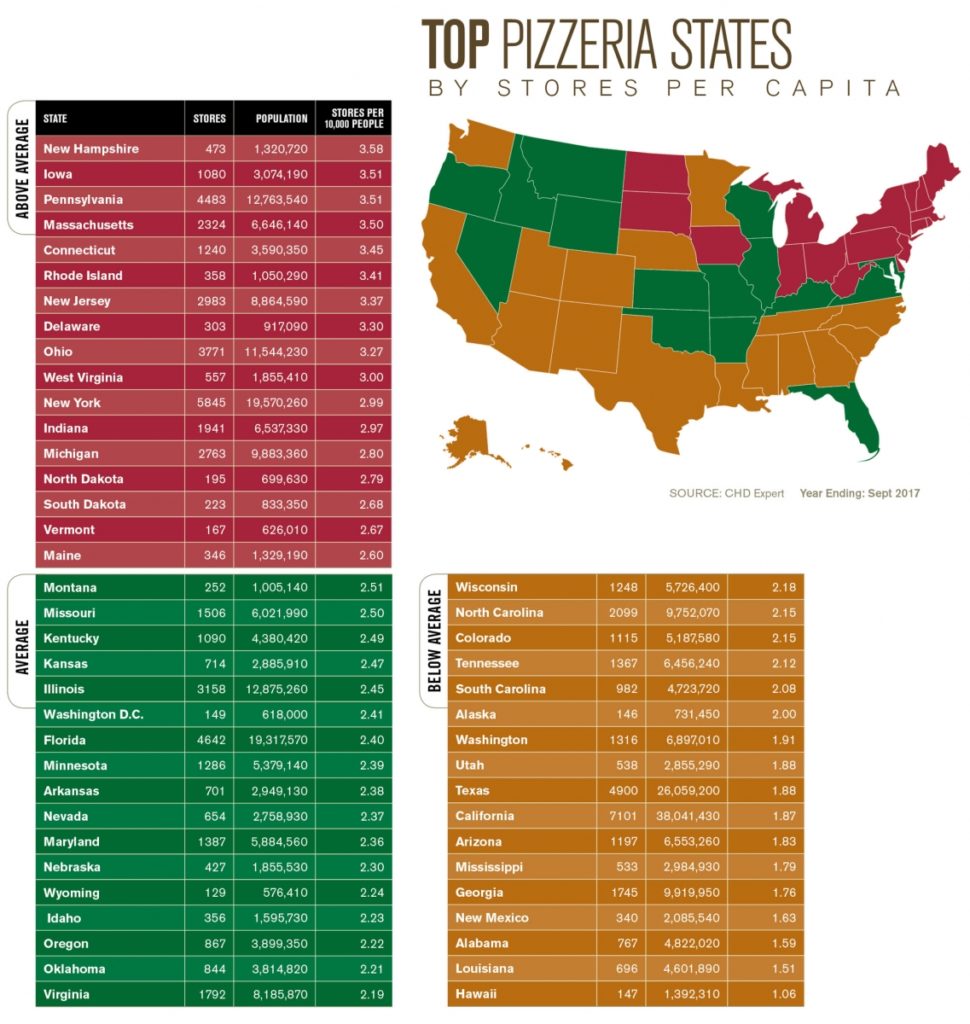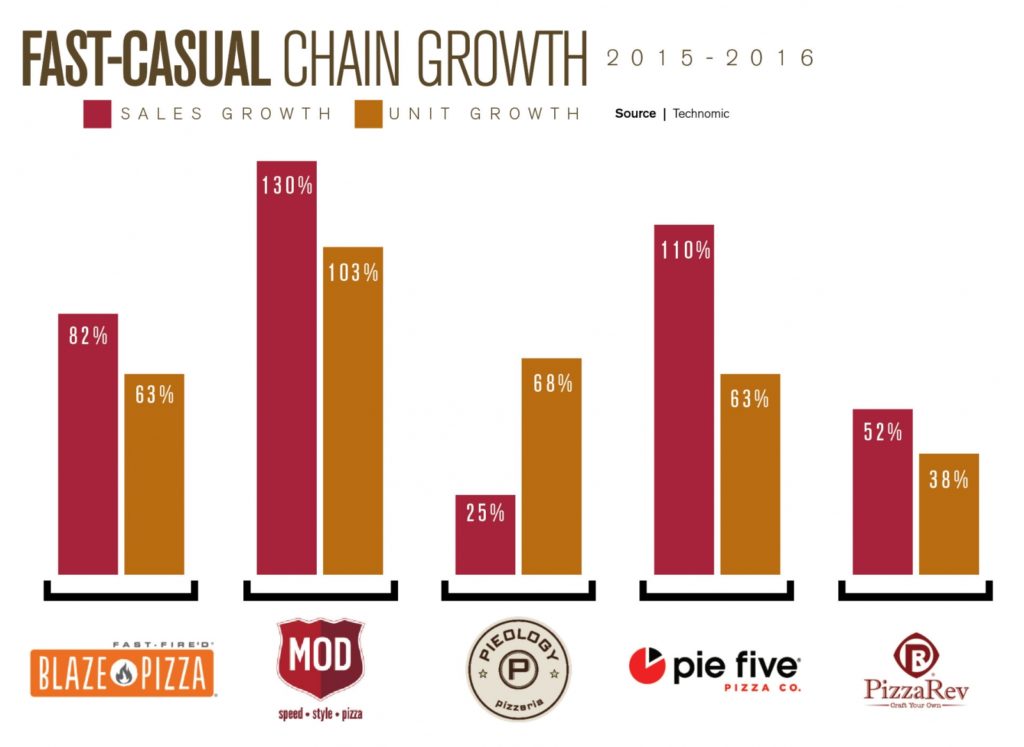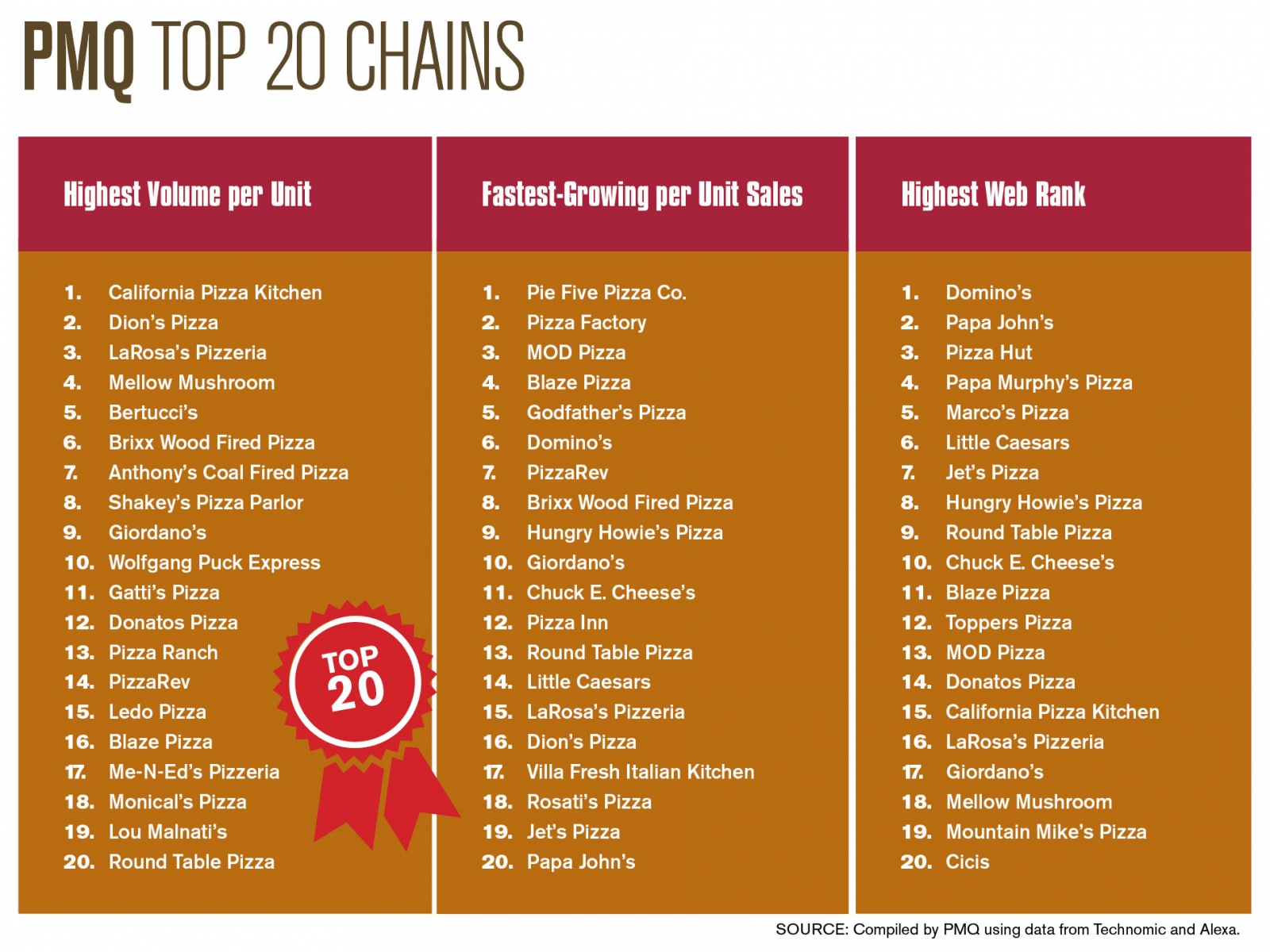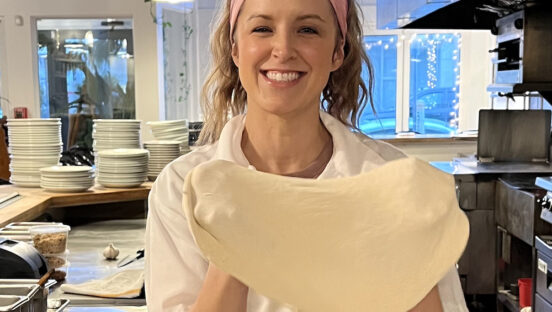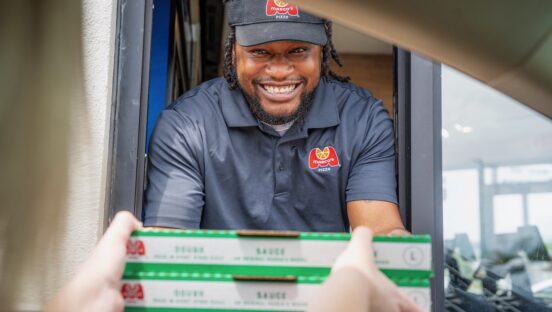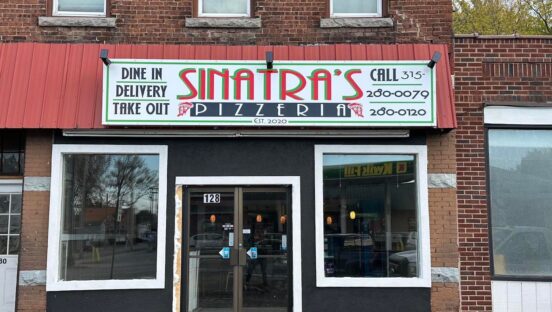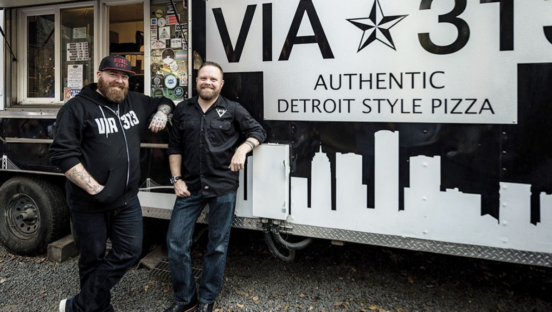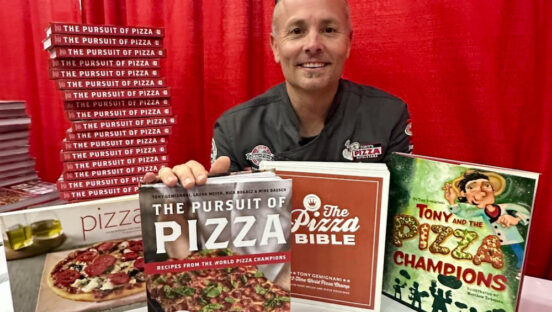This year’s Pizza Power Report practically wrote itself. As we combed through the numbers and reviewed the year’s leading and trailing trends, the same buzzwords and brands kept appearing.
It became crystal clear that pizza consumers want their pizza the way they want it and as fast as they can get it. Fast-casual pizza chains like Blaze Pizza and MOD Pizza showed some of their best unit and sales growth yet, proving that consumers are still yearning for customization and speed in their pizza experience. Domino’s, meanwhile, has blazed new trails with digital technologies that, as we’ll explain later in our report, could soon move the chain into the No. 1 position over Pizza Hut.
Focusing on Consumer Needs
The big winners in the pizza race this past year were those who embraced websites, social media, online ordering and delivery technology. Many of the fastest-growing pizzerias also had the highest web rankings, illustrating that there’s a direct correlation between a strong web presence and healthy sales.
On top of that, consumers are now spending as much money eating out as they do eating at home. According to a recent study in Consumer Reports, around half of every food dollar is spent at restaurants, equaling roughly $2,222 per person, per year.
The survey of 68,950 restaurant-goers told Consumer Reports that nothing matters more in the choice of a restaurant than the taste and quality of the food. And while respondents were satisfied with about half of the restaurants listed in the survey, they did note areas that needed improvement, such as service that was lacking, restaurants that were too noisy, inattentive waiters, and long waits to order and get the check.
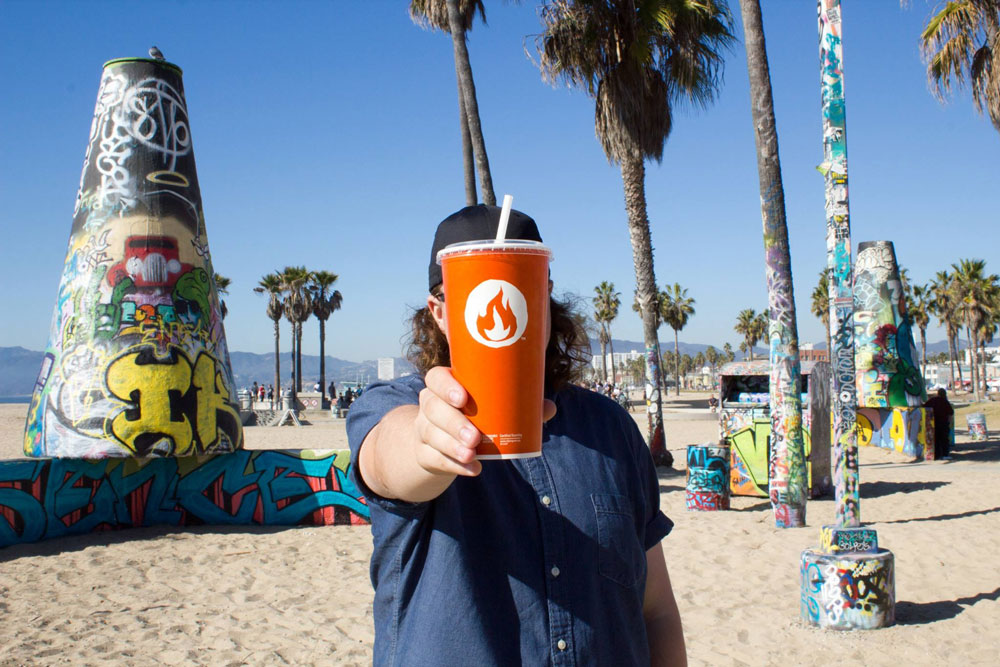 |
|
Business Insider named Blaze Pizza as the fastest-growing pizza chain in the country and pizza itself as the fastest-growing segment of all fast-casual restaurants. |
Since we’re eating out more often, we’re also concerned about affordability. The Nielsen Global Out-of-Home Dining Survey polled more than 30,000 online respondents in 61 countries to understand consumers’ out-of-home dining behaviors and preferences. The top three attributes that North American respondents listed as reasons for choosing a restaurant were Reasonably Priced Food (47%); Food Quality (30%); and Type of Cuisine (25%).
These insights show us that even pizzerias with fantastic websites, great delivery and perfect social media pages can fail if consumers deem them to be too expensive or provide poor customer service.
This year’s industry statistics and trends, presented here in PMQ’s annual Pizza Power Report, will illustrate key areas where you can focus your efforts to guarantee future growth within your business. Let the learning begin!
Making Headlines
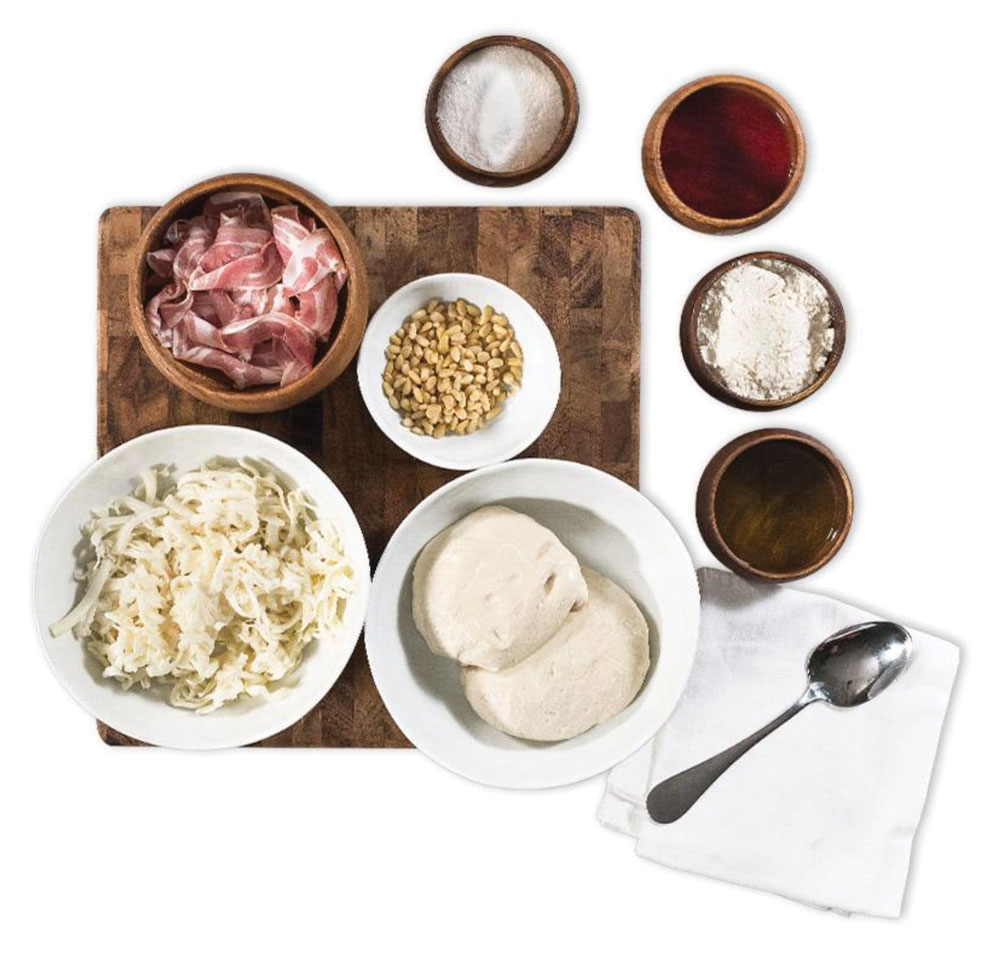
Experimenting With Meal Kits |
| The meal kit category has ballooned to more than $2 billion, according to research firm Pentallect, with restaurants just scratching the surface. According to the National Restaurant Association, 49% of consumers said they would buy meal kits to prepare at home if their favorite restaurant offered them for purchase.
Pentallect’s research showed that, beyond enjoying the experience and the unique items, the main reason consumers use meal kits was “for convenience” (53%). The main reason others did not use meal kits was because they “had no real need” (42%). Pentallect noted that the reasons for not using a meal kit—which also included factors such as “can get what I need elsewhere” and “have not thought about it”—can be overcome with creative marketing. If you’re ready to experiment with meal kits in your pizzeria, start small, with just one or two of your most popular dishes. Make sure the ingredients can be delivered fresh and prepared within 30 minutes. Once the kits catch on, you can expand the offering. |
Never one to shy away from the spotlight, pizza made its fair share of headlines in 2017. In February, a social media frenzy ensued when the president of Iceland, Gudni Thorlacius Johannesson, joked with high schoolers that pineapple pizza should be outlawed.
In June, a tenacious team of pizzaiolos—led by industry giants like Giulio Adriani, Tony Gemignani and John Arena—gathered in Los Angeles to break the Guinness World Record for the world’s longest pizza.
Pizza was also unsurprisingly labeled as the fastest- growing segment of fast-casual restaurants in 2017, with Blaze Pizza named the fastest-growing restaurant chain in the country by Business Insider.
But just as the industry was celebrating these victories, it also had obstacles to overcome—as did the rest of the hospitality industry. Those obstacles included devastating hurricanes in Texas, the Gulf Coast and Puerto Rico; fires in California’s Napa and Sonoma counties; and the ongoing battle for wage increases across the hospitality sector.
No one can control natural disasters, but we can do our part when it comes to wages. “I pay my pizza makers a commission based on the volume we do each night,” says Paul Giannone, founder of Paulie Gee’s in Brooklyn, New York. “It incentivizes them to work harder, and therefore, they always make more than minimum wage.”
Lenny Rago, co-owner of Panino’s Pizza in Chicago, says operators should not be afraid to raise prices to offset rising wages. “Most consumers will pay for quality,” he says. “You have passion for what you do, and you pick your ingredients to give the customer the best product possible. Let the customer know that quality can’t be automated.”
This year’s ups and downs were reflected in an above- average increase in sales, but with most of the gains going to chains. Euromonitor reported a North American industry increase of 4.58%, with chains seeing growth of 5.83%, while independents saw only a 2.65% increase.
Increased Independent Closures
According to CHD Expert, there were 75,243 pizza restaurants in operation at the end of September 2017. A total of 4,992 new pizzerias opened their doors, while 5,291 closed.
Independents opened 2,868 stores and closed 4,121, while chains opened 2,124 and closed 1,170. Last year’s report showed a net store loss for the independents of only 42 units, while this year showed 1,253. Overall, however, the overall net loss of pizzerias for the industry this year was less than last year, at only 299 units.
Despite an above-average number of closures from independents, they still account for a higher percentage of the total industry, with CHD Expert reporting 41,728 independents and 33,515 chains. However, per-unit sales for chain pizzerias are nearly 70% higher than that of independents, according to CHD Expert, with chains reporting $745,557 per store and independents reporting $443,258 per store.
But don’t let per-store sales numbers get you down. Consumers still often choose independents over chains. In fact, Chicago-based food industry consulting firm Pentallect, in collaboration with Critical Mix, conducted consumer research that found consumers rated independent restaurants as superior to chains in 12 of the 15 studied key attributes across both operational and emotional metrics. Some of the top attributes included being community-oriented, offering personalized service and sharing the customer’s values.
International Growth
Large pizza chains continued to expand beyond U.S. borders this year, with a keen focus on nations with rising disposable incomes.
Pakistan is the world’s fastest-growing retail market, according to Euromonitor International, with Pizza Hut planning to double its store count in Pakistan to 150 over the next five years. Almost two-thirds of the 200 million people in Pakistan are younger than 30, according to Bloomberg, with disposable incomes doubling since 2010 and 40% of household expenditure spent on food.
According to a recent article in The New York Times, many nations view Western foods such as pizza and fried chicken as status symbols, furthering the growth of
fast-food brands in places such as Ghana, Africa. And Euromonitor International showed sales at Middle East and Africa pizzerias (chain and independent) growing from $4.29 billion in 2015 to $4.66 billion in 2016.
The Dominance of Domino’s
As this month’s PMQ cover illustration suggests, you can’t talk about pizza in 2017 without talking about the dominance of Domino’s. CEO Patrick Doyle has spearheaded an astonishing resurgence in recent years, as the chain overhauled its recipe and embraced technology to make ordering pizza as easy as pointing a finger. The Los Angeles Times reported in May that Domino’s stock had risen 5,000 percent since 2008, with same-store sales in the United States climbing for 24 straight quarters. As of July, Nation’s Restaurant News noted that Domino’s was “on track to take the pizza segment’s top spot in the near future,” muscling past longtime No. 1 Pizza Hut.
Fast Company named Domino’s one of its Most Innovative Companies of 2017, in part because of its zero-click ordering app that, when opened, automatically sends in the customer’s preloaded preferred order after a 10-second countdown, not to mention its cloud-based AnyWare app that lets users order from their Samsung Smart TV, PlayStation 4, Amazon Echo and even their car (using Ford’s Sync service). All in all, Domino’s offers at least 10 ways to order pizza online, including tweeting a pizza emoji via Twitter or opening a chat on Facebook Messenger.
The company now gets more than 60% of its orders through these various digital platforms. In an October 12 interview with Jim Cramer on CNBC’s Mad Money, Doyle said “natural voice” is the next big development in pizza ordering. “We’ve been talking about natural voice as how we think people are going to interact with technology for a while,” he said in the interview. “We started investing in it three or four years ago. We’re seeing that play out now.”
For its AnyWare suite of products, Amazon Echo’s Alexa voice service has been the strongest performer in terms of total number of orders, Doyle told Cramer. “That keeps growing. Google Home’s doing well. We’re looking at other ways we can use that.”
But Domino’s isn’t just leading the way in ordering innovations. The company has also partnered with Ford to test autonomous delivery vehicles. A specially designed Ford Fusion sedan, which Domino’s has tried out with randomly selected customers in Ann Arbor, Michigan, boasts self-driving technology as well as an actual oven. To get their pizzas, customers must meet the car outside their homes and enter a number on the car’s automated keypad—it’s a delivery without any human interaction. And that’s the real test, company president Russell Weiner has said. “How will customers react to coming outside to get their food? We need to make sure the interface is clear and simple.”
Even if self-driving delivery cars don’t catch on right away, there’s little doubt that Domino’s will continue to assert its dominance in the pizza chain segment through cutting-edge technology and e-commerce. But don’t count Pizza Hut out just yet. Chris Dargis, chief e-commerce officer for Pizza Hut U.S., has roughly doubled his tech department since November 2016 and ramped up the chain’s own digital ordering systems to keep pace with Domino’s. “Pizza Hut understands that digital, especially mobile, is where consumers are, and we want to step up the game around that,” Dargis told DigiDay.com in August.
Menu Matters
Pizza menus saw some action this year as charcoal, unicorn and cauliflower crust pizzas blew up on Instagram; Detroit-style pizza finally got its moment in the spotlight; and gluten-free and vegan slices edged their way into more areas. “We have an extensive vegan menu at all of our locations,” says Giannone. “We have housemade vegan sausage, cashew ricotta and jackfruit meatballs, and we use vegan cheese.”
Giannone and Rago both report a boom in Detroit-style pizza, while Jason Johnston, executive chef of National Harbor in Oxon Hill, Maryland, says he’s noticing a focus on the pizza process more than any particular style. “It feels like people are moving away from drawing pizza lines in the sand,” he says. “The trend is moving toward the guest looking for operators and chefs to own the genre they specialize in by being true to every aspect of the process.”
Johnston says that this is achieved by honoring the dough making process for a particular pizza style, having the right oven, cooking at the right temperature, and delivering a stellar product to the guest. “All of these elements show that we respect the guest and we understand that we owe them that great, authentic pizza experience in our pizza genre specialty,” he says.
Expanded Topping Choices
Build-your-own fast-casual concepts have made it easy for consumers to go beyond pepperoni. Pineapple and chicken may still be considered “adventurous” choices by traditionalists, but dozens of new ingredient options have emerged along the flavor spectrum.
“I like to contrast sweet and savory when I’m coming up with a new pie,” says Giannone. “Our Monte Cristo pie, with mild Gouda, Canadian bacon and a maple syrup drizzle, is just one example.”
“Pizza is, and has always been, an ever-evolving cuisine, especially when it comes to toppings,” says Joseph Englese, executive chef of National Market at MGM National Harbor in Oxon Hill, Maryland, which includes ZiZi’s Pizza. “One of the more interesting things that we have noticed with millennials is their love for ranch dressing and incorporating it into everything they eat, including pizza. At ZiZi’s, we experiment with a variety of toppings, like pineapple, clams and chicken, offering our patrons a chance to expand their palates, but we also maintain a constant presence of the traditional styles.”
As Englese notes, it’s important to incorporate new ingredients while also maintaining tradition, which is reinforced in the most recent findings from Technomic’s 2017 Flavor Consumer Trend Report. Results showed millennials were twice as likely as baby boomers to order ethnic foods at least once a week, while boomers are staying in their comfort zone more than ever. The study did show, however, that there remains a desire for unique offerings, with 42% of the 1,500 respondents saying they expect restaurants to offer signature flavors they can’t get elsewhere.
Local and Organic
Consumers may be getting more adventurous in their topping and crust choices, but many are also nursing long-standing and new allergies, which leads them to request more locally sourced and sustainable ingredients.
The Nielsen Global Health and Ingredient Sentiment Survey polled more than 30,000 online respondents in 63 countries to understand how consumers feel about the foods and beverages available on store shelves. In it, 31% of respondents from North America said they or someone in their household suffers from a food allergy or intolerance.
We’ve already seen some of the big chains, such as Pizza Hut and Papa John’s, eliminate ingredients such as artificial colors, sweeteners and preservatives. This past April, Papa John’s launched a pilot program to introduce organic ingredients at select locations.
“As the general public becomes more knowledgeable about food and food preparation, they will naturally be interested in where the food comes from,” says Derrick Tung, owner of Paulie Gee’s Logan Square in Chicago. “We do our best to focus on clean and local ingredients, but just as important, the quality of ingredients must be excellent, along with a price point that makes sense for our model. If not, it doesn’t make sense to use the ingredient over the long term.”
When it comes to sourcing local, Giannone says he focuses his efforts on helping local businesses more than specific ingredients. “We try to support local artisans that make products such as honey, ice cream, bakery goods, and other items that can help their businesses,” he says.
Not everyone thinks local sourcing is such a big deal. Sometimes, what really matters is delivering on customer expectations, Rago notes. “I don’t know if local ingredients make a big difference, as long as you use a decent product that the consumer likes,” he says.
But Johnston says if you’re asking customers to pay a premium, you should be providing a premium product. “Being locally sourced is always a focal point for cooks, chefs and pizzaioli,” he says. “This is extremely important for VPN and American artisan styles, where we’re asking the guest to pay up to $20 or more for a 10” pizza. It’s our responsibility to be giving the best, most seasonal ingredients to our guests.”
Nutrition Labeling
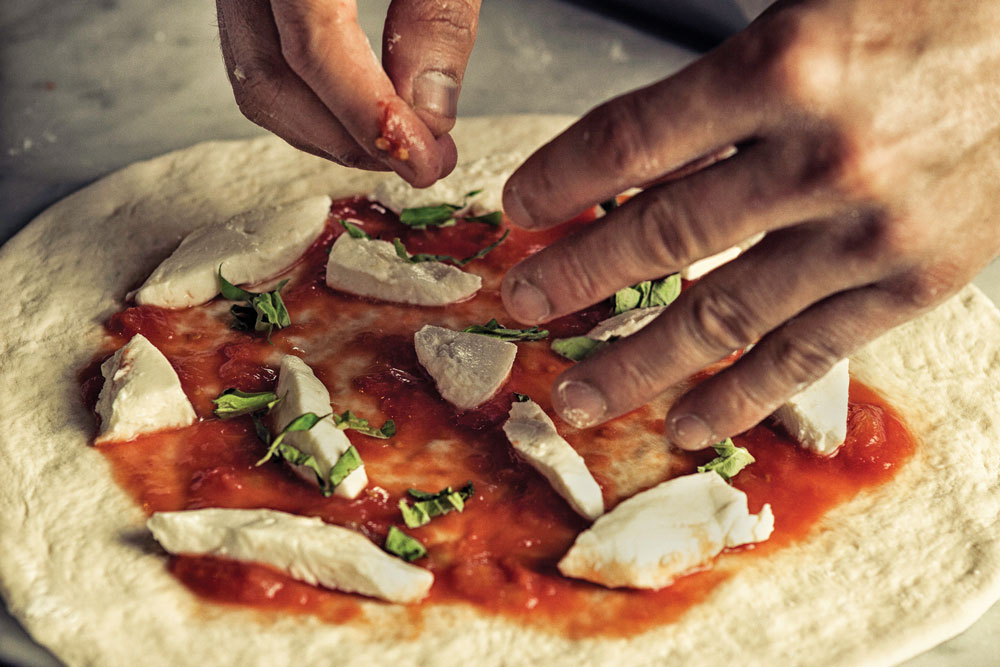
Customization and Speed Are Key |
| Beyond technology’s presence in every aspect of the pizza industry, two of the biggest takeaways from this year’s Pizza Power Report are the increasing desire for customization and the need for faster delivery.
The more you can meet these metrics, the more loyalty you’ll be able to build, according to Brand Keys in New York, which studies customer loyalty engagement and recently ranked Domino’s, Papa Murphy’s and Papa John’s as the pizza leaders in Customer Loyalty Engagement. Robert Passikoff, Brand Keys founder and president, says, “The big driver of loyalty is taste and something that’s morphed into what we call ‘made-to-order’ taste. Consumers are looking for real quality in their pizzas and love the idea of customizing what they really want. “What’s gaining real momentum in creating loyalty is speed of delivery and ‘order options,’” Passikoff adds. “Based on the consumption numbers, Americans can’t get their pizzas fast enough. According to our expert loyalist consumers, there’s room for improvement in the delivery area, something the national chains don’t have an exclusive on.” |
The saga continues: In May 2017, the FDA extended the compliance date for menu labeling requirements from May 5, 2017, to May 7, 2018, allowing extra time to consider the costs and flexibility of the requirements. While many pizzeria operators breathed a sigh of relief when given the extra time, new research shows that posting calories, whether or not it’s required by law, could actually increase your customer count.
One study, “The Effect of Calorie Posting Regulation on Consumer Opinion,” was co-authored by data researchers from the University of Southern California, the National University of Singapore, and Cornell University. They analyzed 761,962 restaurant reviews across 9,805 restaurants in New York City from 2004 to 2012. The authors found a significant increase in the proportion of reviews that discussed health for chain restaurants, relative to nonchain restaurants.
Additionally, in a Mintel survey of 1,799 internet users who have visited a pizzeria in the last three months, 41% said they would like to see healthier side items offered; 36% were interested in whole-grain pizza crust; and 31% showed an interest in organic ingredients.
Smarter Ordering
Remember when the phone would ring, you’d pick it up, and someone would ask for a pizza?
Hard to believe that was only a few years ago. Now it seems like consumers will go out of their way just to avoid talking to you. Some will avoid your pizzeria altogether if they find out that calling is the only way to order a pizza. And, with online ordering, consumers now have the option of ordering through a pizzeria’s website, a smartphone app, social media, with the help of a chat bot, or through a third-party website.
EMarketer reports that 69% of internet users have ordered food delivery online within the past year, and large pizza chains—like the aforementioned Domino’s and Pizza Hut—are looking more like tech companies as they continue to dazzle customers with digital marketing and robotics.
Meanwhile, some independent pizzerias that fought against online ordering are now taking a second look. Many have found that declining sales got a hefty boost after adding online ordering.
All businesses, not just pizzerias, are looking at the big chains for their ability to take a consumer from online advertisement to order in a matter of clicks. Like Domino’s, Papa John’s now reports that digital orders make up more than 60% of its sales, while they account for about half of Pizza Hut’s delivery and carryout business. Numbers like that are hard to ignore.
PMQ’s 2018 Pizza Industry Census revealed that 58% of operators currently offer online ordering, owing 5% to 15% of their sales to the added feature.
Before you write off online ordering as a delivery-only feature, about 40% of the order volume on Slice is for pickup and takeout, according to the online ordering company. More than delivery, online and mobile ordering is about providing convenience, accessibility and information to customers, whether they want to order for pickup, delivery, or dine-in.
Delivering Faster
The introduction of third-party delivery companies has been a boon for struggling pizzeria operators who have been dealing with rising wages and turnover rates. But many have realized there’s no substitute for in-house delivery, especially if you’ve already been handling it successfully for years. When using third-party delivery partners, it’s vital to understand how well your food travels—along with a host of other considerations.
In the survey by AlixPartners, among those who order delivery, 71% said they prefer to get delivery directly from the restaurant, while only 8% said they prefer it through a third-party intermediary. There are also fees associated with third-party delivery that may not be worth it if you already have in-house delivery drivers on the payroll.
Meanwhile, large companies continue to experiment with drones and robots that may eliminate the need for delivery drivers—both in-house and third-party—
altogether.
Building Loyalty
Loyalty has been the buzzword this past year, with numerous studies and lists calling out the loyalty leaders in every industry from restaurants to cosmetics. Not surprisingly, pizza ranked high in the loyalty category, with chains such as Domino’s, Pizza Hut and Papa John’s right at the top.
In the past, independent operators have dismissed loyalty programs as flash-in-the-pan money and time wasters, but many are coming around to the fact that loyalty is one of the top factors helping the chains around them grow by leaps and bounds.
Loyalty goes beyond a stamp card. With the help of POS machines, brands can track when a customer orders, what he orders, and when he’s likely to order again. Some brands even use games, a tactic referred to as gamification, to encourage customers to play along and earn points toward food and drink rewards.
Loyalty doesn’t always equal visits, however, as illustrated in a recent study by Mintel. Consumers don’t have a strong loyalty to one chain over another, the study concluded, and, when given the choice, they’d actually recommend more premium pizza, such as California Pizza Kitchen and Blaze Pizza, to their friends. However, larger chains, with more locations, are visited more often than smaller brands due to their availability and convenience.
Social Media
Boston-based Toast polled 450 restaurateurs in 2017 and found that, while 74% were using Facebook for their business, more than half of those surveyed do not use YouTube, LinkedIn or Snapchat, nor did they intend to in 2017. However, YouTube did show the most growth potential, with 28% of respondents reporting an intention to begin using YouTube.
Pizzerias that have even one video on YouTube can claim their pizzeria’s channel on PizzaTV (register.pizzatv.com/join), helping to bring more exposure to their store through regional and independent promotions.
In PMQ’s 2018 Pizza Industry Census, pizzeria operators reported their top three social media outlets were Facebook (81%), Twitter (35%) and Instagram (41%).
According to Toast’s survey, restaurateurs are now spending the majority of their advertising dollars on social media ads, whereas in the past, marketing dollars were allocated to charity sponsorships and newspaper ads. While 47% of fast-casual concepts said they would increase their ad spend in 2017, the same Toast survey showed that 21% of pizzerias planned to decrease their ad spend—a greater decrease than any other type of restaurant concept.
Ads and social media are just part of the equation. Online reviews are also an important factor affecting if and why consumers frequent your pizzeria. Only 9% of consumers do not read online reviews, according to a 2016 Local Consumer Review Survey conducted by BrightLocal. The research found that the top three ways consumers reviewed or recommended a local business were via word of mouth (68%), Facebook (47%) and Google (25%). Of the 1,062 survey respondents, 58% look at overall star rating when judging reviews, 59% look at two to three review sites before making a decision, and seven out of 10 said they would leave a review if they were asked.
You can encourage reviews on your own pizzeria by placing reminders on checks, with tabletop signage and through thank-you emails. Creating a link to various review sites on your website is also a great way to boost your reviews.
Need another reason to encourage reviews? Many online review readers will sort businesses by “highest rated” or “most reviewed,” meaning yours will fall to the bottom of the list if it has only a few reviews.
Staffing
Employee turnover rates remained highest for the hospitality industry this year, leading some, most notably Zume Pizza in Mountain View, California, to explore introducing robots into the pizzeria kitchen.
Similarly, RoDyMan (short for Robotic Dynamic Manipulation) is a robot that attempts to mimic a human chef who stretches and tosses pizza dough. The project has been going on for five years and is scheduled to debut at the Naples Pizza Festival in May 2018. Famed pizzaiolo Enzo Coccia was recruited to help in the robotic programming by wearing a sensor-tracking suit that follows his pizza making movements.
In PMQ’s 2018 Pizza Industry Census, 46% of respondents said they would be interested in exploring robotics or automatic machinery in their kitchens.
It doesn’t have to come down to robots, however. Operators acknowledge that hiring and keeping employees is tough but not impossible. “I hire people at an entry level,” says Giannone. “I don’t hire a dishwasher who wants to be a dishwasher. I hire a dishwasher who wants to be a pizza maker. They end up working harder because they want to move up to being a pizza maker.”
Above all else in 2018, look at improving the speed of your processes. Whether that means faster delivery, more people answering the phones, or shorter wait times for food coming out of the kitchen, get food out fast and hot. If you haven’t explored online ordering, social media or delivery yet, this may be the year to start experimenting, either in-house or through a third-party provider. Be a pizza success, not a statistic.




